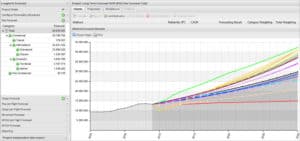With increasing global access to ever-more robust high-speed Internet connections, technology is becoming an integral and dominant part of our daily lives — from how we communicate to how we learn. Training for aviation professionals is no exception. As aviation training leaders look to the future, IATA’s Training and Development Institute (ITDI) points to how they have placed technology at the core of their training design and delivery strategy to ensure their courses have the gold standard in aviation training.
THE INCREASING DEMANDS FOR AVIATION TRAINING
 Training providers in the aviation industry must cater to a demand whereby both the number of skilled personnel, and the breadth of the skills they require, continue to increase. This is no small challenge. The International Civil Aviation Organization (ICAO), along with IATA, Airports Council International (ACI), the Civil Air Navigation Services Organization (CANSO) and other industry leaders, set global, regional and local training requirements so that our industry remains safe, secure, operationally efficient, cost-effective and environmentally sustainable. From this perspective, the main role of training providers in aviation is to ensure that current aviation professionals meet these requirements and that they maintain and improve their knowledge and skills in our fast-changing industry.
Training providers in the aviation industry must cater to a demand whereby both the number of skilled personnel, and the breadth of the skills they require, continue to increase. This is no small challenge. The International Civil Aviation Organization (ICAO), along with IATA, Airports Council International (ACI), the Civil Air Navigation Services Organization (CANSO) and other industry leaders, set global, regional and local training requirements so that our industry remains safe, secure, operationally efficient, cost-effective and environmentally sustainable. From this perspective, the main role of training providers in aviation is to ensure that current aviation professionals meet these requirements and that they maintain and improve their knowledge and skills in our fast-changing industry.
On the other hand, the same training providers must ensure that younger generations are enticed by careers in aviation and can easily access training to acquire the knowledge and skills needed to support the industry around the globe.
To meet this dual challenge, aviation training must be both effective and efficient. It must allow for a rapid transfer of the required know-how and aptitudes from subject matter experts to aviation professionals. Furthermore, it must be easily accessible and flexible, while providing a reasonable return on investment. IATA understands this reality and, as part of our vision to be the force for value creation and innovation, we have chosen to integrate leading-edge technologies in the development and delivery of our courses to enhance our global reach and facilitate access to aviation knowledge.
THE CHANGING FACE OF TRAINING
With advancements in technology and changes in the learning styles of younger generations of aviation professionals, the design and delivery of training is also rapidly changing. From the traditional classroom setting to other forms of training – such as the use of games and simulation to develop greater critical-thinking and problem-solving skills, eLearning, eBooks, and online assessments – training is certainly evolving.
In Africa there has been a ten-fold increase since July 2009 in the availability of reliable bandwidth. In addition, access to Internet services is now reaching many previously underserved States on the continent following the inauguration of the African undersea fibre optic cable. As a result, the number of handheld devices and smartphones have sharply increased, opening the door for IATA and other leaders in this field to make e-training more accessible, thereby diminishing the chance that any country will be left behind.
SIMULATION-BASED SCENARIOS IN TRAINING
The use of simulation in the aviation industry is certainly not new. It has been known through several decades with the use of flight simulation training devices for pilot and air traffic controllers. With continuing technological and pedagogical advancements, the successes of simulation training have been recognized by both educational institutions and businesses that have adapted this technology to their specific needs.
 Technology-based simulation exercises like allow individuals to experience the practical adaptation of theoretical learning. They are put in a situation with defined parameters and are required to achieve business growth using concepts, principles, techniques and strategies which they learned in the theoretical training sessions.
Technology-based simulation exercises like allow individuals to experience the practical adaptation of theoretical learning. They are put in a situation with defined parameters and are required to achieve business growth using concepts, principles, techniques and strategies which they learned in the theoretical training sessions.
More recently, IATA expanded its technology-based simulation capability by adding to its training portfolio the Airport Strategic Management with Business Simulation course conceived specifically for senior management. Following seven days of theoretical learning, course participants are assigned a managerial role in an airport, and over three days they are asked to use simulated systems that replicate a real-business and operational environment. The students have to make strategic planning and operational decisions in order to successfully achieve positive business outcomes at the conclusion of the simulation.
The use and adaptation of simulation technology at IATA also goes well beyond training. Indeed, it is also being developed and successfully used through partnerships in the area of consulting business. The simulation allows for real-world application of projected scenarios, both present and future. A recent example includes a consulting initiative intended to alleviate congestion and delays at the El Dorado Airport in Bogotá, Colombia. The simulation study involved the redesign of airspace, the optimization of airside capacity, and air traffic management systems. Similarly, a Level of Service assessment study was carried out for the Bonaire International Airport N.V., in Bonaire, Dutch Caribbean, in preparation of a planned expansion of the existing passenger terminal.
eLEARNING AND THE VIRTUAL CLASSROOM
In October 2015, IATA, in collaboration with Harvard Business Publishing, launched its inaugural eLearning and virtual classroom course in Aviation Leadership Development; a real-time, cohort-based virtual learning workshop that allows students to participate in live training sessions using online video and messaging no matter where they are in the world. The success of this new training medium is apparent in the high number of participants who have already enrolled. The learning medium opens new doors to the realm of knowledge transfer, keeping the costs to a minimum for the learner, reducing time away from the office, and cutting out the costs for travel and accommodation usually associated with in-classroom training.
ONLINE ASSESSMENTS
IATA is also capitalizing on adaptations to existing systems through the implementation of online exams in the Travel and Tourism sector that make the examination process faster, more efficient, and more cost-effective. There was some initial skepticism from both students and instructors, raising questions mostly about connectivity and potential disruptions in areas of the world that have less reliable power and Internet connectivity. However, the feedback received after the pilots were held in the Americas and the Middle-East have been very positive. A tutorial introduces students to the online exam process and demonstrates the functionality and capabilities of this technology. Students are able to replicate the real-life examination experience to ensure they are comfortable when they eventually sit for an online exam. This new functionality will continue to be rolled out for IATA’s self-study courses and with IATA’s global training partners.
![iata-tablet]() CONTINUING NEED FOR INSTRUCTOR-LED SESSIONS
CONTINUING NEED FOR INSTRUCTOR-LED SESSIONS
As we strive to sustainably connect and enrich our world, complete replacement of face-to-face classroom training is improbable. There are benefits associated with interpersonal, face-to-face dialogue and networking that are difficult to replace with an entirely remote learning scenario. IATA has chosen to diversify its approach and capitalize on the most appropriate learning medium for the subject matter, the format of the knowledge transfer, and the background of the trainees to accommodate a range of adult learning styles.
SUSTAINABLY CONNECTING AND ENRICHING OUR WORLD
The use of technology assists to connect and enrich our world. As new technology is introduced and continues to be developed for our industry, the opportunities for incorporating technology into our learning sphere continue to grow, making it much easier for people to connect and for us to reach them faster than ever before. We can improve our methodologies and platforms quickly, as we have more interactions with more individuals, allowing us to transfer knowledge more efficiently in a variety of ways globally, leaving no country behind. However, we need to be cognizant that these efforts will gain the greatest advantage for our industry if they are supported by a global collaboration among all key international aviation training institutions. That is the best way to provide this generation of aviation professionals – as well as the next – with quality, relevant and accessible training.
 About the Author
About the Author
Guy Brazeau is IATA’s Director of the Training and Development Institute and IATA Consulting and has more than 35 years of experience in aviation,30 of which have been at the international level. Mr. Brazeau has worked as a project director, lecturer and consultant in more than 45 States on airport and civil aviation-related projects and lectured the Airport Management course at Canada’s McGill University.

